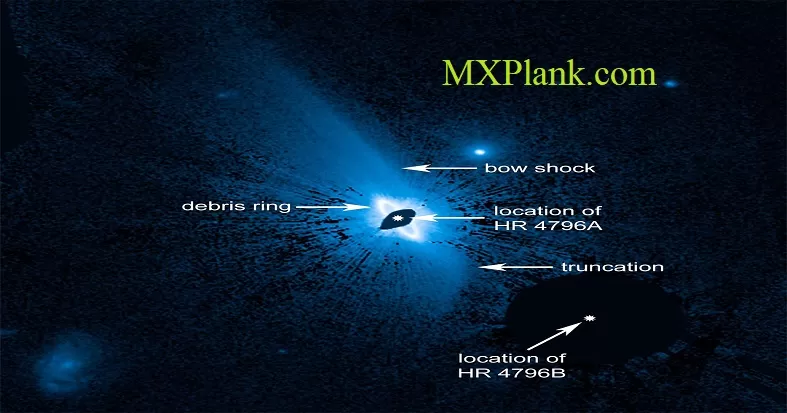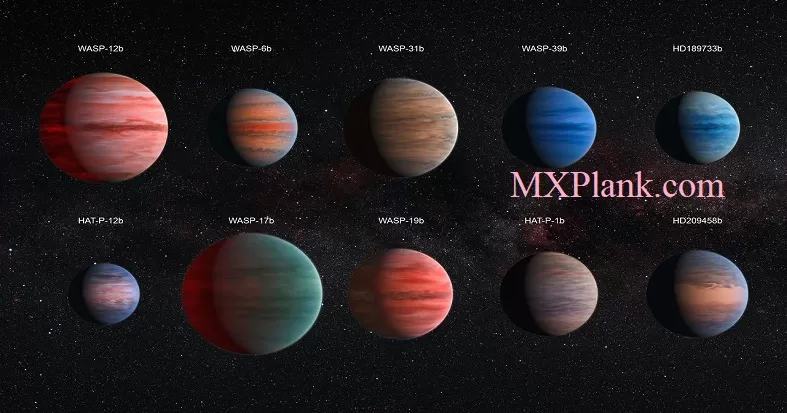Artist's concept of extrasolar planet's Hazy atmosphere

This is an artist's concept of HD 189733b and its parent star.
This far-off blue planet may look like a friendly haven - but don't be deceived! Weather here is deadly. The planet's cobalt blue color comes from a hazy, blow-torched atmosphere containing clouds laced with glass. Howling winds send the storming glass sideways at 5,400 mph (2km/s), whipping all in a sickening spiral. It's death by a million cuts on this slasher planet!
HD 189733 b is a gas giant exoplanet that orbits a K-type star. Its mass is 1.13 Jupiters, it takes 2.2 days to complete one orbit of its star, and is 0.0313 AU from its star. Its discovery was announced in 2005.
Huble's Space Telescope Imaging Spectrograph measured changes in the color of light from the planet before, during and after a pass behind its star. There was a small drop in light and a slight change in the color of the light. "We saw the light becoming less bright in the blue but not in the green or red. Light was missing in the blue but not in the red when it was hidden," said research team member Frederic Pont of the University of Exeter in South West England. "This means that the object that disappeared was blue."
Earlier observations have reported evidence for scattering of blue light on the planet. Hubble observations confirmsed the evidence.
If seen directly, this planet would look like a deep blue dot, reminiscent of Earth's color as seen from space. That is where the comparison ends.
On this turbulent alien world, the daytime temperature is nearly 2,000 degrees Fahrenheit, and it possibly rains glass - sideways - in howling, 4,500-mph winds. The cobalt blue color comes not from the reflection of a tropical ocean as it does on Earth, but rather a hazy, blow-torched atmosphere containing high clouds laced with silicate particles. Silicates condensing in the heat could form very small drops of glass that scatter blue light more than red light.
Hubble and other observatories have made intensive studies of HD 189733b and found its atmosphere to be changeable and exotic.
This far-off blue planet may look like a friendly haven - but don't be deceived! Weather here is deadly. The planet's cobalt blue color comes from a hazy, blow-torched atmosphere containing clouds laced with glass. Howling winds send the storming glass sideways at 5,400 mph (2km/s), whipping all in a sickening spiral. It's death by a million cuts on this slasher planet!
HD 189733 b is a gas giant exoplanet that orbits a K-type star. Its mass is 1.13 Jupiters, it takes 2.2 days to complete one orbit of its star, and is 0.0313 AU from its star. Its discovery was announced in 2005.
Huble's Space Telescope Imaging Spectrograph measured changes in the color of light from the planet before, during and after a pass behind its star. There was a small drop in light and a slight change in the color of the light. "We saw the light becoming less bright in the blue but not in the green or red. Light was missing in the blue but not in the red when it was hidden," said research team member Frederic Pont of the University of Exeter in South West England. "This means that the object that disappeared was blue."
Earlier observations have reported evidence for scattering of blue light on the planet. Hubble observations confirmsed the evidence.
If seen directly, this planet would look like a deep blue dot, reminiscent of Earth's color as seen from space. That is where the comparison ends.
On this turbulent alien world, the daytime temperature is nearly 2,000 degrees Fahrenheit, and it possibly rains glass - sideways - in howling, 4,500-mph winds. The cobalt blue color comes not from the reflection of a tropical ocean as it does on Earth, but rather a hazy, blow-torched atmosphere containing high clouds laced with silicate particles. Silicates condensing in the heat could form very small drops of glass that scatter blue light more than red light.
Hubble and other observatories have made intensive studies of HD 189733b and found its atmosphere to be changeable and exotic.
Credit:
NASA/ESA and The Hubble Heritage Team (STScI/AURA)
NASA/ESA and The Hubble Heritage Team (STScI/AURA)






